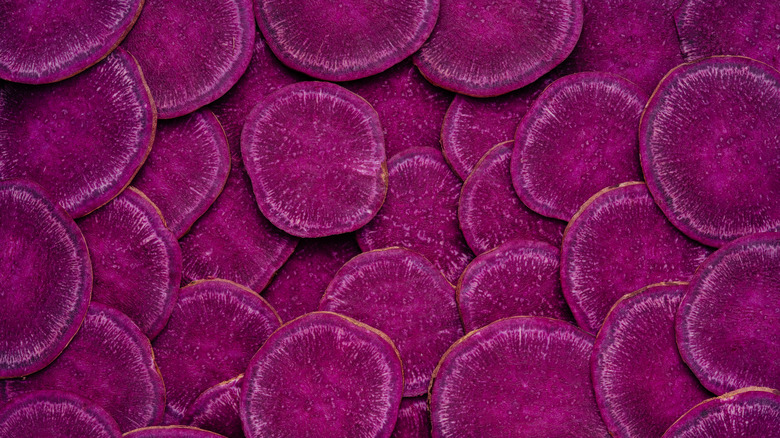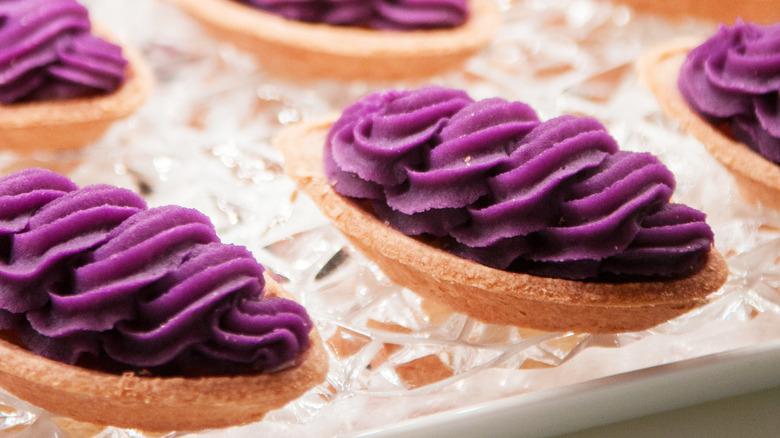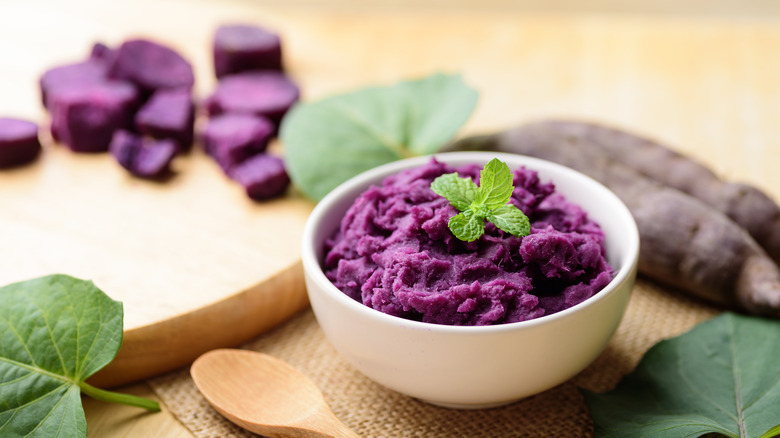How To Get The Best Flavor Out Of A Purple Sweet Potato
You can roast an orange sweet potato at 350 degrees Fahrenheit in around 45 minutes. If you have a purple sweet potato, though, you'll need double or nearly triple the cooking time — anywhere from 90 minutes to two hours. This is because purple sweet potatoes are sturdier and contain less water than the orange variety; they need a little extra time to develop their creamy, soft, decadent texture and deep flavor. To keep them from drying out during this extended time in the oven and to develop that creaminess, you can ensure they retain their moisture even when roasting by wrapping them in some foil to trap the steam.
There are multiple kinds of purple sweet potatoes, including the Molokai, Shinzami, Murasaki, and Charleston. Two of the most common in the U.S. are the Okinawan and Stokes. Okinawan purple potatoes, also known as Japanese or Hawaiian sweet potatoes, have a subtle, honey-like quality. Meanwhile, Stokes purple potatoes are dense and starchy, with a drier sweetness that evokes a glass of wine. Depending on who you ask, some will tell you that one is drier and the other is creamier, but there is no true consensus on which is which. Purple sweet potatoes can be used in the same capacity as orange sweet potatoes, from savory to sweet recipes.
Achieving the best flavor
Coconut milk is often used to bring out the flavors in purple sweet potatoes, whether savory or sweet. Any kind of purple sweet potato can be used in a gluten-free baked sweet potato dessert, getting mashed and mixed with coconut milk, blueberries, cinnamon, and honey.
Because of their complex, wine-y notes, Stokes sweet potatoes excel in recipes with pungent ingredients. They can be mashed or roasted with butter and herbs like rosemary and thyme or turned into fries and served with a spiced ketchup or truffle garlic aioli. All of these earthy flavors play on this variety's particular taste. Turning towards a Southern classic, baker Joanne Canady-Brown of The Gingered Peach uses the purple tubers for her spin on a traditional sweet potato pie; she enhances the colorful spuds with cardamom, ginger, and orange rather than the typical nutmeg and cinnamon.
The Okinawan sweet potato is an essential staple in Hawaii and Japan, and its subtler flavor makes it versatile. It's popular as a component in lau lau, a Hawaiian dish of pork and butterfish, and in Japanese curries. It also fills pastries like manju and mochi, highlighting its color and sweet, honeyed flavor. In Japan, the purple sweet potato is everywhere, from McDonald's shakes to KitKat bars to ice cream to cakes to the ubiquitous beni-imo tart, a popular shortcrust boat filled with sweet potato paste. It's clear that people worldwide love these tubers for their nuanced taste as much as their visual impact.
Why are they purple?
The purple sweet potato is said to have originated — like other potatoes — from Central and South America. Historians believe that they got to Japan in the early 17th century; from there, the purple tuber made it to Hawaii by way of the Polynesian Islands. The Stokes potato, on the other hand, has a more recent origin: According to lore, Mike Sizemore, a car-thief-catcher turned retiree farmer in North Carolina who won a state fair prize for growing sweet potatoes in 2003, was handed unidentified purple sweet potatoes of unknown origin by a mystery woman. He liked their hue and savor so much that he ended up cultivating and patenting them.
The deep purple color of these sweet potatoes comes from a naturally occurring compound called anthocyanin. A known antioxidant, it's what gives most red, purple, and blue plants their color. Usually, foods this high in anthocyanins are bitter, but not purple sweet potatoes.
If you want to eat purple sweet potatoes for their antioxidant properties, your oven is your best tool. A study of Korean purple sweet potatoes showed that steaming the tubers lowers the anthocyanin content by half, but roasting only slightly reduces it. A Food Chemistry study on a variety called P40 showed that pressure cooking, microwaving, and frying also significantly reduced the presence of anthocyanins but confirmed that baking affected them the least. (Luckily, you can mashed potatoes from baked spuds.) Although it takes longer, it deepens their flavor and preserves their antioxidants.


